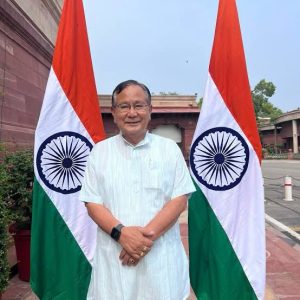
Dr K Srinath Reddy
ChatGPT’s advent has led to concerns about convincingly crafted fake research papers polluting scientific literature.
“I wish men would get back their balance among the elements. And be a bit more fiery, as incapable of telling lies as fire is.” So wrote D H Lawrence in his poem Elemental (1929).
Unfortunately, people do tell lies and often present them as facts, statements or conclusions which deviate from the true nature of events. While this behaviour is dishonest in any area of work, it can be particularly disastrous in the area of health research. By falsifying research findings, misreported or fraudulent publications can misguide medical management and endanger lives. Research misconduct in medicine includes fabrication or falsification of data, selectively reporting data which suits a particular conclusion while omitting contrary data, or even completely inventing a study that was never conducted. Lesser transgressions include plagiarism, claiming credit for a study to which the scientist made no significant contribution, or rolling out many publications from the same data analysis. The penalties for each of these categories vary within and across countries.
The pressure on researchers in academic medical institutions to publish prolifically and in prestigious journals is immense since promotions as well as peer recognition depend on this. This increases the temptation to resort to devious practices. Research grants, too, flow more copiously to researchers who have previously published in that area or an allied field. Awards are also conferred aplenty, as researchers with a blazing track of publications are boosted into higher echelons of the academic world.
In the early 1980s, the academic world was shocked when John Darsee, a brilliant young researcher at Harvard, was guilty of fabricating data and publishing fraudulent papers in renowned journals. Prior to this, he was regarded as a superstar and rewarded with a faculty position by the famous Harvard cardiologist Eugene Braunwald—who also featured as a senior author in some of Darsee’s papers. On initial exposure of fraud, one paper was first retracted but later, several other past publications were found to be flawed or fabricated. Many publications had to then be retracted. Darsee left Harvard in disgrace.
Several lessons emerged from this episode. The hunger for success and recognition can lure a bright mind onto the wrong path. “Publish or perish” was the motto in most academic institutions. Senior authors who were not involved in the fraud were still guilty of not checking the data carefully before lending their name to the papers. Early investigations were a hurried exercise to protect the image of the institution. However, younger researchers were observant of the flaws, investigated the records, exposed the fraud and ensured action.
Rules related to research misconduct were framed thereafter, requiring all authors to declare the nature of involvement with the research and the related manuscript. For academic promotions, attention was shifted from the number of publications to the quality of the top five or ten identified by the researcher. Duplicate publications and plagiarism drew opprobrium but not severe penalties. Plagiarism was punished through administrative censure and stalled advancement in one’s academic career. Despite this, fraud has continued. When exposed, authors retracted the papers voluntarily or under pressure from journal editors. Many countries, including India, have had some researchers accused or found guilty of research fraud. With an increasing number of journals, including digital publications, an exponential rise in research publications has occurred in recent years. The peer review process has become overwhelmed and fraudulent research finds it easier to slip through a slipshod review process.
During the pandemic, the phenomenon of pre-prints emerged wherein papers were placed in the public domain even before peer review. While this facilitated a quick sharing of scientific observations during a public health emergency, it also presented an opportunity to publish doctored papers with dressed up data. Between January 2020 and October 2021, 157 Covid-related papers were retracted. Several of them were in prominent journals. Two of them were on the effects of hydroxychloroquine and some blood pressure medicines on Covid. It was diligently probed by other researchers, leading to the exposure of dubious data. Selective reporting or censoring of data can also be misleading. A recent dispute between American interventional cardiologists and cardiac surgeons relates to ‘evidence-based’ guidelines on coronary stenting versus bypass surgery.
The advent of digital technology has also provided greater ease to researchers in altering radiologic images and photographs of pathological findings. Apart from image distortion, the use of artificial intelligence can create convincingly publishable fake images. Stanford University recently investigated its president, Marc Tessier-Lavin, a renowned neuroscientist, after some of his scientific publications were detected to have altered images. Was he personally responsible or merely an insufficiently attentive senior author like Braunwald? In either case, the lapse damages his reputation while bringing research into disrepute.
The explosive growth of ChatGPT has led to concerns about convincingly crafted fake research papers polluting scientific literature. Unless the institutions employing the researchers can vouch for the actual conduct of research and veracity of data, such manuscripts can fool reviewers, journals and readers.
It is clear that medical research will continue to face the problem of misconduct or even plain fraud because the stakes are high in the publication race. This calls for much better training on research and publication ethics to young researchers, much greater diligence in supervision and integrity in co-authorship for their senior colleagues and mentors, a painstakingly thorough peer review process, close scrutiny by editorial staff of journals, and acceptance by institutional leaders to take prompt, punitive action against their errant employees who wilfully commit research fraud. It also calls for a consistent and universally adopted reward system of academic promotions and grants which values quality of publications over quantity and social impact of the research over the prestige of the journal where it is published. If this does not happen, fake medical research will do as much harm as fake medicines.
(The writer is a Cardiologist, epidemiologist and Distinguished Professor of Public Health, PHFI)





